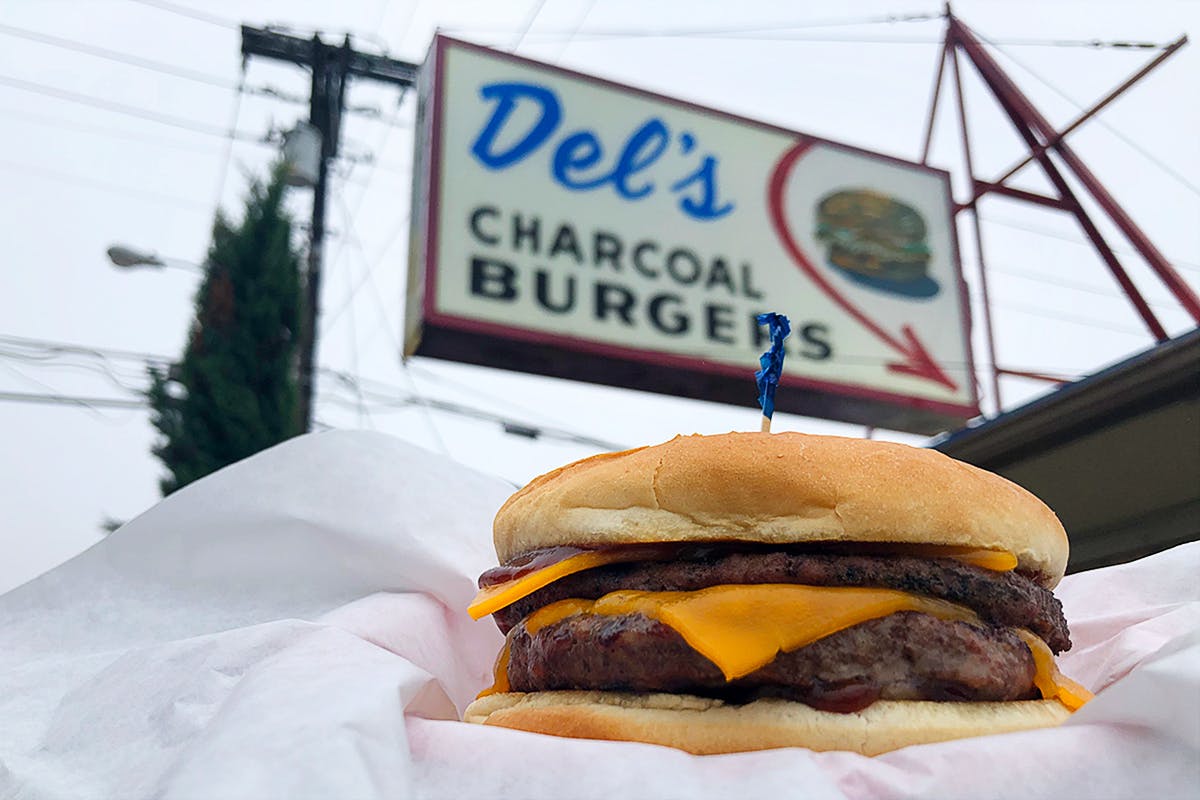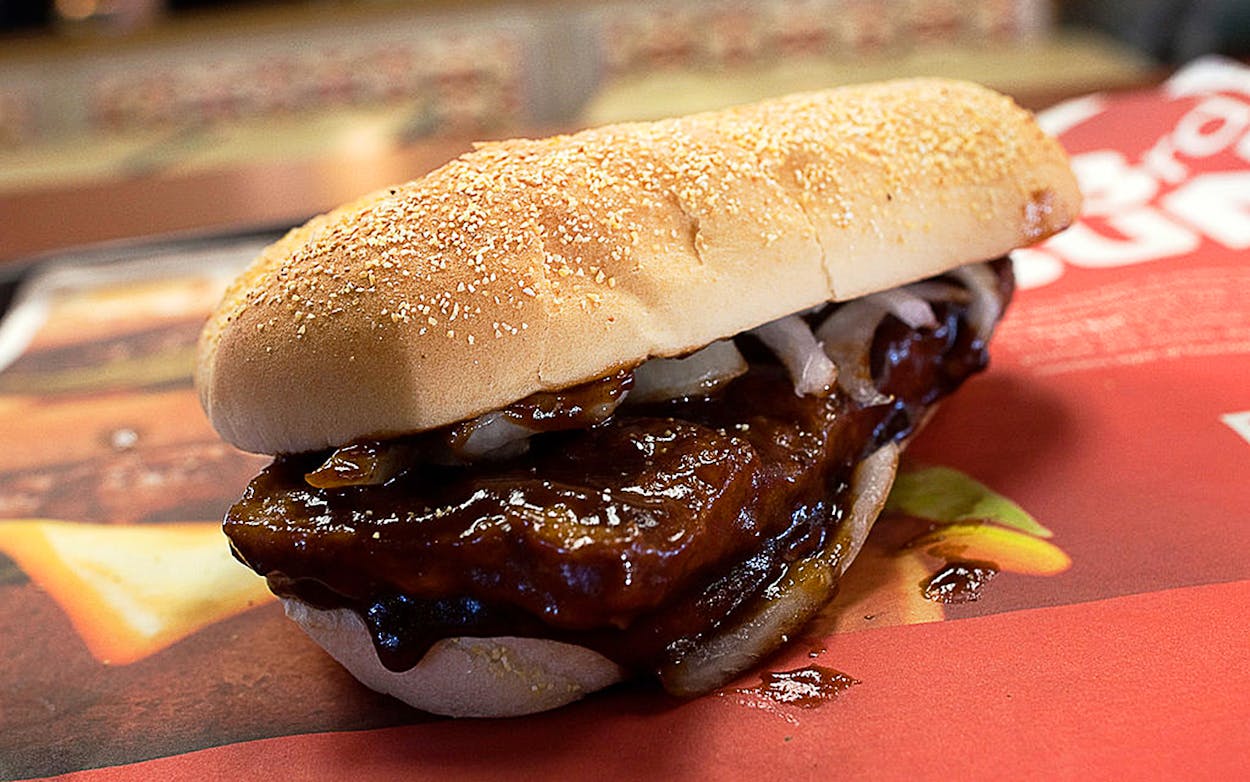I recently sampled the new brisket sandwiches being hawked by chains from Arby’s and Subway to Quiznos. But before I get to that, let’s explore how the terms “barbecue” and “barbecued” have evolved over the past couple hundred years. Throughout most of the nineteenth century, a barbecue was any sizable event where people gathered to eat meats—usually whole animals—cooked over fire or wood coals. The food served was always referred to as “barbecued meat” rather than “barbecue.” Once meat markets and roadside shacks began selling similarly prepared meats, around the beginning of the twentieth century, “barbecue” came to mean the food served by those establishments. If you were eating barbecue, you knew by definition it was some form of meat that had been cooked over wood or coals—perhaps, but not necessarily, smoked. But barbecue aficionados today would be upset if a joint were serving meat that hadn’t been smoked, the same way Texans are unhappy when invited to a backyard “barbecue” that involves a gas grill and hot dogs.
“Not long ago, I ordered barbecue without the sauce in a restaurant that advertised a barbecue plate. When the meat came, I saw that all on earth it was was roast beef,” columnist J. Frank Dobie complained in the Fort Worth Star-Telegram in 1952. He was writing about the rising popularity of backyard cooks who used barbecue sauce as a crutch for bad cooking. “This mixture is guaranteed to deaden the perfume of the choicest meat,” he said, referring to a recently published barbecue sauce recipe containing ketchup, butter, sugar, and Worcestershire sauce. Of the sauce, he said, “It will help to disguise the taste of bad meat cooked badly.” Dobie further lamented that, “for a lot of people, a heavy douse of sauce turns a plain roast into ‘barbecue.'” He was right to be frustrated. Over the previous couple of decades, he’d witnessed the term “barbecued” diverge far from its original meaning.
In 1926, the Dallas Gas Company ran an advertisement in the Dallas Morning News that featured Smilo Mallison’s “barbecued chicken” recipe, which touted how little gas fuel would be required to cook the chicken in an oven. Mallison’s secret sauce included lard and butter along with vinegar, Worcestershire sauce, mustard, and red pepper. This was the same year that Maull’s barbecue sauce in St. Louis became the first bottled sauce sold in stores. Barbecue sauce was the dominant flavoring in a 1933 recipe for barbecued chicken that was also published in the Dallas Morning News, this one from WFAA’s Jimmy Jeffries. The oven-cooked chicken was covered in a sauce made from butter and ketchup with some Worcestershire sauce and lemon juice.
“At home, a broiling oven makes a very acceptable barbecuer if the broiling pan can be placed 5 to 8 inches from the source of the heat,” Martha Logan wrote in the Fort Worth Star-Telegram in 1941. She was describing the variations in barbecue flavor that can be provided by using different sauces. “Since the popularity of barbecued meats has spread from coast to coast, it is natural we should find great variation in recipes for the kinds of meats called ‘barbecued,'” she continued. Her preference was a thick Texas-style sauce on her oven-cooked meats.
Around this same time, bottled barbecue sauces became ubiquitous on grocery store shelves, following the success of Maull’s. These were marketed as shortcuts to barbecue flavor. No longer was cooking over wood or coals a requirement for barbecue. You could pour on a bottle of sauce and call anything “barbecued.”
As part of a 1939 advertising campaign for its bottled ketchup, Heinz offered a recipe for “barbecued hamburg patties” done on the stovetop, each patty coated with a sauce made from ketchup. A decade later, it was Oscar Mayer that stashed a “sack o’ barbecue sauce” inside cans of cooked pork, beef, and even wieners. The sauce was to be mixed with the canned beef to make what the company called “barbecue burgers,” which seems more like a sloppy joe than true barbecue.

Barbecue sauce on hamburgers became a popular combination in the 1950s, and many of the restaurants that popularized it are still around. Bud’s Broiler was opened in New Orleans in 1952 by Alfred “Bud” Saunders, who had previously worked for his father at the Holliday Hill restaurant in Austin. Bud’s continues to put its original-recipe hickory sauce on charcoal-grilled burgers. A similar burger can still be had at Vicco’s Charcoalburger Drive-in, opened in 1953 in Glenwood Springs, Colorado. The now closed Split-T opened the same year in Oklahoma City. Johnnie Haynes left the Split-T in 1971 to give us Johnnie’s Charcoal Broiler. The #1, at its eight locations in Oklahoma City, is a burger with Johnnie’s hickory sauce. In the Dallas area, Richardson still has the hickory burger from Del’s Charcoal Burgers, which opened in 1957.
In 1958, the young burger chain Whataburger, which didn’t grill its burgers over charcoal, developed a new menu item. In an advertisement in the Aransas Pass Progress, it announced the debut of the Barbecue Burger. “It is made with one-sixth pound of pure beef, a generous portion of our own barbecue sauce, and large slices of white Bermuda onions,” the ad reads. The same year, the first flavored potato chip in America came out of Pennsylvania. Herr’s snack company released a barbecue-flavored chip. Today it seems strange to imagine only plain potato chips on the shelf, but Lay’s didn’t offer other flavors until 1965. Its first? Barbecue.

The meaning of barbecue had morphed from a celebration to a cooking method to a flavor that could be applied to most anything. The bottled barbecue sauces weren’t like the old-style mop sauces that were mostly vinegar, water, and spices. These new sauces were thick, sweet, and tomato-based. To mimic barbecue flavor, they needed an umami boost from Worcestershire sauce and, most importantly, a good dose of liquid smoke flavor that you couldn’t get in an oven. Look at the label of nearly any barbecue sauce on store shelves today and you’ll find liquid smoke, which you’ll need if you want to turn those boneless skinless chicken breasts in the skillet into “barbecued” chicken. I still remember the barbecue sandwiches my mom used to make. She’d stir together chopped, fatty ham from the deli counter with bottled barbecue sauce in a pot and serve it on buns. Back then, this Ohio kid thought he was eating barbecue.
The fast-food giants jumped onto the barbecue bandwagon more recently. (See my Ultimate Fast-Food Barbecue Sauce Taste Test.) In 1981, McDonald’s introduced the McRib, which proved unpopular and left the menu in 1985. Brought back for a limited time in 1989, it’s become a favorite as the restaurant re-releases it briefly and sporadically each year since. The McRib’s second coming may have gotten a boost from the popularity of the Bull’s Eye Barbecue Burger from Burger King, introduced in 1987. It featured two beef patties topped with barbecue sauce, cheese, and bacon. A spokesman for Burger King, RJ Trutz, told the San Jose Mercury News back then that “barbecue-flavored foods are no longer a regional phenomenon, but are the favorites of consumers across the country. The Bull’s Eye Barbecue Burger will allow us to capitalize on this fast-growing market segment.”
I ate a McRib recently. Not all of it—just enough to study the flavor and texture of the ground pork patty coated in barbecue sauce. I admire the faith McDonald’s puts into the barbecue sauce on this sandwich. The sauce does the heavy lifting. The patty could have been vegetable protein and provided the same effect. It was there for texture, not flavor. I don’t think anyone eating a McRib thinks they’re eating actual barbecue or a rib. The same can be said for folks who try the barbecue burger at Wendy’s, or the BBQ Bacon Whopper at Burger King, or add barbecue sauce to their Whataburger. The “barbecue” element of all of those is solely the sauce.
Arby’s, Subway, Quiznos, and Schlotzsky’s have chosen a different route recently. They’ve sought to legitimize their sandwiches as true barbecue alternatives. Arby’s Smokehouse Brisket Sandwich was added to its permanent menu in 2014. Schlotzsky’s offered a smoked brisket sandwich earlier this year. Quiznos added their Pit-Smoked Brisket Sandwich in July, and Subway launched its Naturally Pit-Smoked Brisket Sandwich in September. Arby’s, Quiznos, and Subway use slices of real brisket that have been smoked by a vendor. I guess that’s to convince folks of their barbecue bona fides, but then they do the same thing every other fast food joint does to its barbecue sandwiches: drown the meat in sauce.
I’ve eaten enough of the Arby’s brisket sandwiches to know the dominant flavor is the thick, sweet sauce. There’s a slice of smoked gouda on there too. Subway uses smoked cheddar. They went to all the trouble of sourcing smoked brisket, but then apparently figured they better add some insurance with the cheese (Quiznos uses regular cheddar). I’ve tried four of Subway’s brisket sandwiches at four different locations. None of the restaurants assembled it the same way. One location asked if I wanted the thinly sliced brisket cold or hot. But all of them were liberal with the sauce, which along with the pickles and onions I added, covered up most of the meat’s flavor. Why even bother using briskets smoked for thirteen hours by Pitmaster Ramone and his crew when they could just as easily have used roast beef?
I never thought I’d say I respect the McRib more than a brisket sandwich, but that’s where I’ve landed. McDonald’s doesn’t try to pretend there’s any sort of authenticity to its sandwich. The McRib and all these other barbecue burgers aren’t barbecue. We know it, and so do the brands that produce them. They’re barbecue-flavored sandwiches and are comfortable having no higher aspirations. The wannabe barbecue at Arby’s, Quizno’s, and Subway is just a poor version of the real thing, but can they admit that to themselves? I think their secret’s right there in the sauce.








